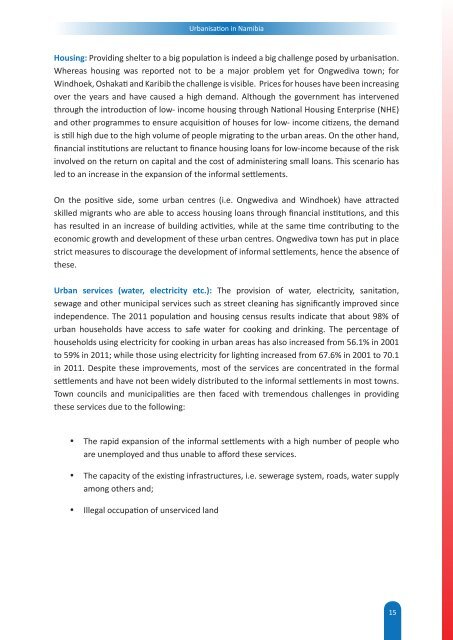Urbanisation-in-Namibia
Urbanisation-in-Namibia
Urbanisation-in-Namibia
Create successful ePaper yourself
Turn your PDF publications into a flip-book with our unique Google optimized e-Paper software.
<strong>Urbanisation</strong> <strong>in</strong> <strong>Namibia</strong>Hous<strong>in</strong>g: Provid<strong>in</strong>g shelter to a big population is <strong>in</strong>deed a big challenge posed by urbanisation.Whereas hous<strong>in</strong>g was reported not to be a major problem yet for Ongwediva town; forW<strong>in</strong>dhoek, Oshakati and Karibib the challenge is visible. Prices for houses have been <strong>in</strong>creas<strong>in</strong>gover the years and have caused a high demand. Although the government has <strong>in</strong>tervenedthrough the <strong>in</strong>troduction of low- <strong>in</strong>come hous<strong>in</strong>g through National Hous<strong>in</strong>g Enterprise (NHE)and other programmes to ensure acquisition of houses for low- <strong>in</strong>come citizens, the demandis still high due to the high volume of people migrat<strong>in</strong>g to the urban areas. On the other hand,f<strong>in</strong>ancial <strong>in</strong>stitutions are reluctant to f<strong>in</strong>ance hous<strong>in</strong>g loans for low-<strong>in</strong>come because of the risk<strong>in</strong>volved on the return on capital and the cost of adm<strong>in</strong>ister<strong>in</strong>g small loans. This scenario hasled to an <strong>in</strong>crease <strong>in</strong> the expansion of the <strong>in</strong>formal settlements.On the positive side, some urban centres (i.e. Ongwediva and W<strong>in</strong>dhoek) have attractedskilled migrants who are able to access hous<strong>in</strong>g loans through f<strong>in</strong>ancial <strong>in</strong>stitutions, and thishas resulted <strong>in</strong> an <strong>in</strong>crease of build<strong>in</strong>g activities, while at the same time contribut<strong>in</strong>g to theeconomic growth and development of these urban centres. Ongwediva town has put <strong>in</strong> placestrict measures to discourage the development of <strong>in</strong>formal settlements, hence the absence ofthese.Urban services (water, electricity etc.): The provision of water, electricity, sanitation,sewage and other municipal services such as street clean<strong>in</strong>g has significantly improved s<strong>in</strong>ce<strong>in</strong>dependence. The 2011 population and hous<strong>in</strong>g census results <strong>in</strong>dicate that about 98% ofurban households have access to safe water for cook<strong>in</strong>g and dr<strong>in</strong>k<strong>in</strong>g. The percentage ofhouseholds us<strong>in</strong>g electricity for cook<strong>in</strong>g <strong>in</strong> urban areas has also <strong>in</strong>creased from 56.1% <strong>in</strong> 2001to 59% <strong>in</strong> 2011; while those us<strong>in</strong>g electricity for light<strong>in</strong>g <strong>in</strong>creased from 67.6% <strong>in</strong> 2001 to 70.1<strong>in</strong> 2011. Despite these improvements, most of the services are concentrated <strong>in</strong> the formalsettlements and have not been widely distributed to the <strong>in</strong>formal settlements <strong>in</strong> most towns.Town councils and municipalities are then faced with tremendous challenges <strong>in</strong> provid<strong>in</strong>gthese services due to the follow<strong>in</strong>g:• The rapid expansion of the <strong>in</strong>formal settlements with a high number of people whoare unemployed and thus unable to afford these services.• The capacity of the exist<strong>in</strong>g <strong>in</strong>frastructures, i.e. sewerage system, roads, water supplyamong others and;• Illegal occupation of unserviced land15


